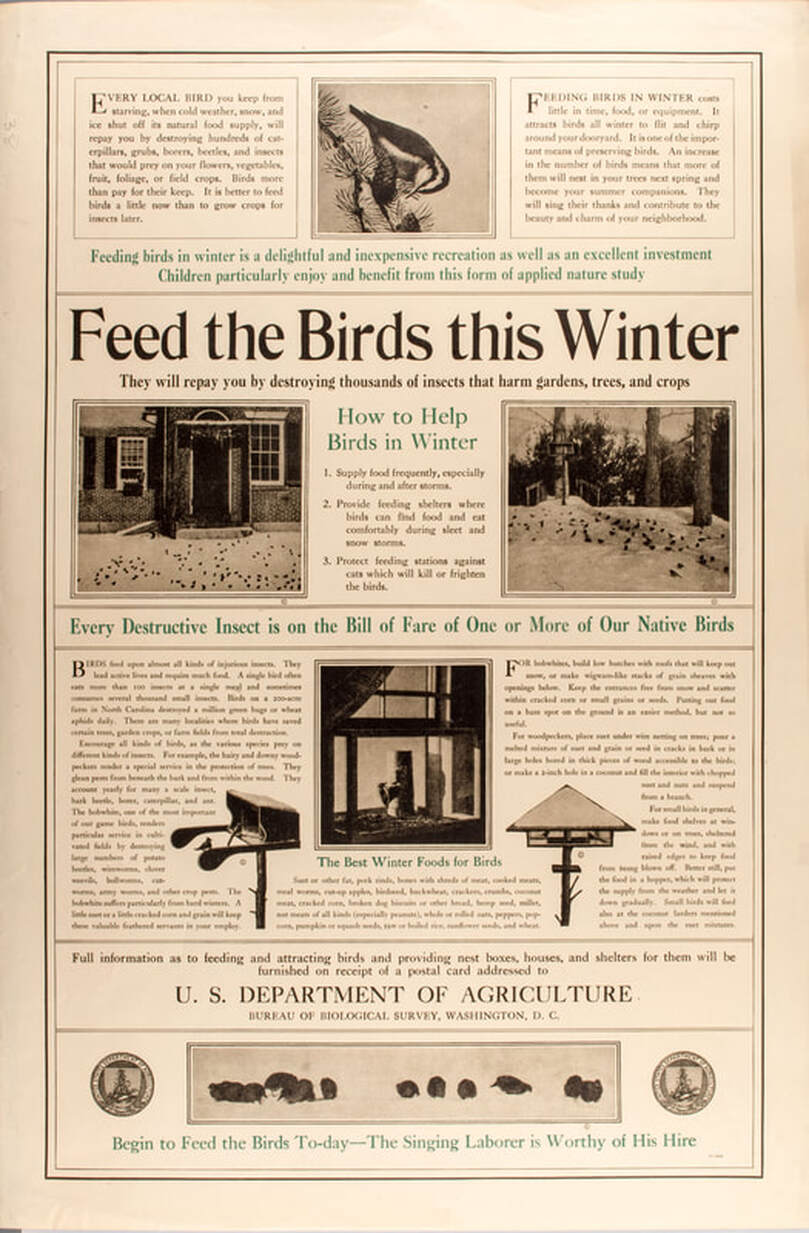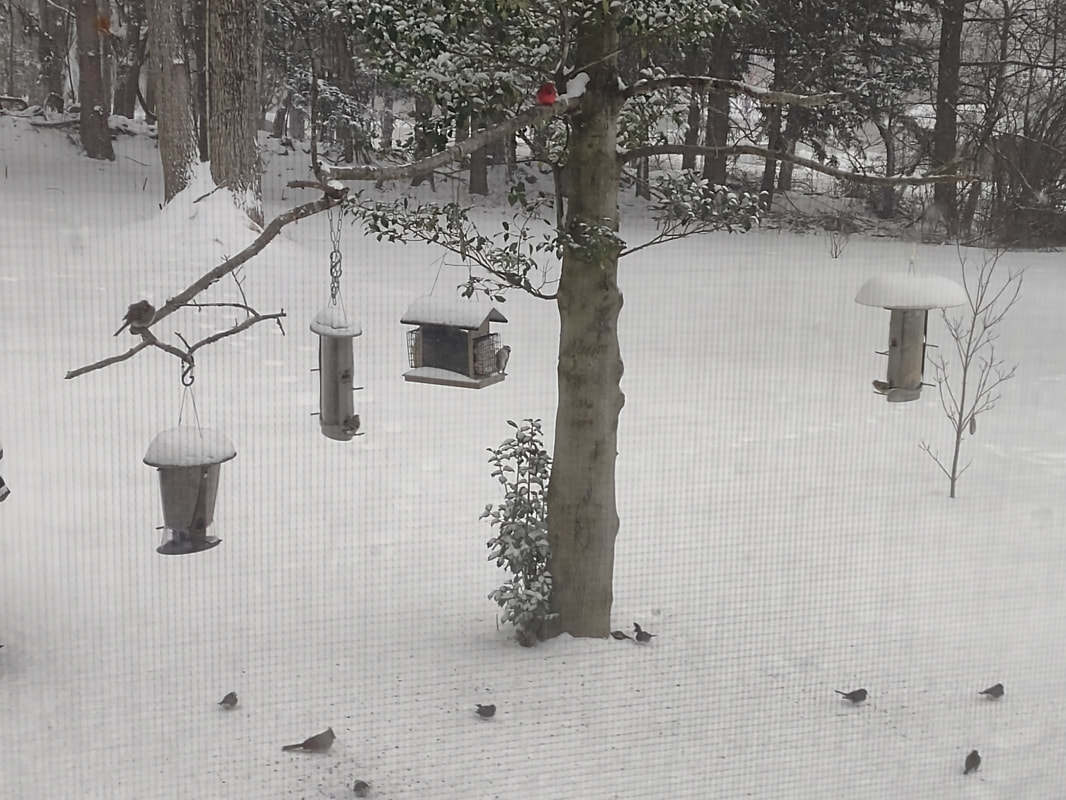|
We're getting into some of the more obscure WWI posters now! This poster is from the United States Department of Agriculture, specifically the Bureau of Biological Survey. "Feed the Birds This Winter: They will repay you by destroying thousands of insects that harm gardens, trees, and crops" is the main message of this poster. Suggesting that ordinary Americans feed birds "especially during and after storms," provide shelter, and protect feeding areas from bird predators, the poster connects "our native birds" to their insect-eating abilities. This is a very text-heavy poster, so I've transcribed it all so you can know what it says! "EVERY LOCAL BIRD you keep from starving, when cold weather, snow, and ice shut off its natural food supply, will repay you by destroying hundreds of caterpillars, grubs, borers, beetles, and insects that would prey on your flowers, vegetables, fruit, foliage, or field crops. Birds more than pay for their keep. It is better to feed birds a little now than to grow crops for insects later. "FEEDING BIRDS IN WINTER costs little in time, food, or equipment. It attracts birds all winter to flit and chirp around your dooryard. It is one of the most important means of preserving birds. An increase in the number of birds means that more of them will nest in your trees next spring and become your summer companions. They will sing their thanks and contribute to the beauty and charm of your neighborhood. "Feeding birds in winter is a delightful and inexpensive recreation as well as an excellent investment. Children particularly enjoy and benefit from this form of applied nature study." "Feed the Birds this Winter. They will repay you by destroying thousands of insects that harm gardens, trees, and crops. "How to Help Birds in Winter "1. Supply food frequently, especially during and after storms. "2. Provide feeding shelters where birds can find food and eat comfortably during sleet and storms "3. Protect feeding stations against cats which will kill or frighten the birds. "Every Destructive Insect is on the Bill of Fare of One or More of Our Native Birds. "BIRDS feed upon almost all kinds of injurious insects. They lead active lives and require much food. A single bird often eats more than 100 insects at a single meal and sometimes consumes several thousands small insects. Birds on a 200-acre farm in North Carolina destroyed a million green bugs or wheat aphids daily. There are many localities where birds have saved certain trees, garden crops, or farm fields from total destruction. "Encourage all kinds of birds, as the various species prey on different kinds of insects. For example, the hair and downy woodpeckers render a special service in the protection of trees. They glean pests from beneath the bark and from within the wood. They account early for many a scale insect, bark beetle, borer, caterpillar, and ant. The bobwhite, one of the most important of our game birds, renders particular service in cultivated fields by destroying large numbers of potato beetles, wireworms, clover weevils, bollworms, cut-worms, army worms, and other crop pests. The bobwhite suffers particularly from hard winters. A little suet or a little cracked corn and grain will keep these valuable feathered servants in your employ. "FOR bobwhites, build low hutches with roofs that will keep out snow, or make wigwam-like stacks of grain sheaves with openings below. Keep the entrances free from snow and scatter within cracked forn or small grains or seeds. Putting out food on a bare spot on the ground is an easier method, but not so useful. "For woodpeckers, place suet under wire netting on trees; pour a melted mixture of suet and grain or seed in cracks in bark or in large holes bored in thick pieces of wood accessible to the birds; or make a 2-inch hole in a coconut and fill the interior with chopped suet and nuts and suspend from a a branch. "For small birds in general, make food shelves at windows or on trees, sheltered from the wind, and with raised edges to keep food from being blown off. Better still, put the food in a hopper, which will protect the supply from the weather and let it down gradually. Small birds will feed also at the coconut larders mentioned above and upon the suet mixtures. "The Best Winter Food For Birds "Suet or other fat, pork rinds, bones with shreds of meat, cooked meats, meal worms, cut-up apples, birdseed, buckwheat, crackers, crumbs, coconut meat, cracked corn, broken dog biscuits or other bread, hemp seed, millet, nut meats of all kinds (especially peanuts), whole or rolled oats, peppers, popcorn, pumpkin or squash seeds, raw or boiled rice, sunflower seeds, and wheat. "Full information as to feeding and attracting birds and providing nest boxes, houses, and shelters for them will be furnished on receipt of a postal card addressed to U.S. DEPARTMENT OF AGRICULTURE, Bureau of Biological Survey, Washington, D.C. "Begin to Feed the Birds To-Day - The Singing Laborer is Worthy of His Hire." Much of this advice is still sound today! At the time, of course, it was marrying not only nature study for children (a VERY popular topic during the Progressive Era) but also advocating for more natural forms of pest control in a time when pesticides existed, but had limited applications, and the availability of which was likely curtailed by more important wartime manufacturing. Birds do require an incredible number of insects to survive (bats, too), and even seed and fruit-eating songbirds feed their nestlings insects to give them the protein and fat they need to grow. Today, more and more farmers are returning to birds - from raptors to songbirds - to address pest issues, from pest birds (like starlings and seagulls) and rodents to insects. In some instances, the birds outperform pesticides. And contrary to what most people put in their bird feeders, birds eat a LOT of insects. Which is why I was surprised and happy to see mealworms on the list of recommended foods for birds, alongside suet and nuts. I've been feeding the birds in winter and early spring (we take the feeders down in the summer) to support the population, but also to let up a little on the insect population. Unlike 100 years ago, we're currently facing an insect apocalypse, which could have huge repercussions across the planet, including, but not limited to, agriculture, as many of our favorite crops rely heavily on pollination from wild insects. Which is why, even though I'm not a farmer and we're not at war, I still feed the birds in the winter. You can see my setup in the photo above - I have several squirrel-proof feeders (determined squirrels can get by even the baffles, but they provide shelter for the birds during the rain) with different mixes. One is a fruit, nut, and shelled sunflower seed mix with mealworms. Two more are just straight black oil sunflower seed. One has suet, and another feeder, which we're trying new this year, is just straight mealworms and beetles. Sadly, that one has been less popular. Maybe those insects don't have enough fat in them. Our half-dead holly tree provides enough spreading branches for the feeders but also cover from predators like hawks. Birds like to have cover they can escape to when predators come calling. And yes, that includes cats! Outdoor and feral cats are the number one predator of songbirds in suburban and urban areas. So keep your kitties inside or build them a catio. If they knew it in WWI, we should know it now. It is most important to support native birds, and not pest birds like starlings (who, while fascinating, are native to Europe and can out-compete native birds), so keep your food focused on native seeds, fruits, and nuts whenever possible. Just watch out for inexpensive fillers that aren't eaten by most songbirds. Sunflower seeds, peanuts, pecans, walnuts, raisins, blueberries, and cracked corn are all great. Suet (raw or rendered beef fat) is also good, as is natural peanut butter (avoid the hydrogenated kind, the kind with palm oil, and sugar), for providing the fat needed to keep birds warm and well-fed during the coldest winter months. I have set up our bird feeders right outside the kitchen window, and like Progressive Era nature study enthusiasts knew, they do provide a great deal of joy. I love coming to the kitchen every morning and checking to see what birds are at the feeders, and which ones need refilling. Since it has been incredibly cold and icy here in the Hudson Valley of New York this winter, our feeders have been almost as busy as Grand Central! We've seen cardinals, blue jays, tufted titmice (my favorites!), nuthatches, chickadees, sparrows, purple house finches, gold finches (they're mostly brown in the winter), downy woodpeckers, red breasted woodpeckers (whose breasts are actually just pink - it's the heads that are red!), dark-eyed juncos, mourning doves, and yes, even the occasional starling. More rarely we've seen cedar waxwings, rose-breasted grosbeaks (another favorite!), phoebes, and even the rare overwintering bluebird (though not actually on the feeders). Another way to support native birds (and insects!) is to plant native plants, especially fruit-producing shrubs for birds. For insects, native trees, especially oaks, can host up to 400 species of insects, including moths and butterflies. Okay, I'll get off my soapbox now! But always nice to see good sense from a century ago still holding true today. Do you feed the birds? Have a favorite winter visitor? Tell us in the comments! The Food Historian blog is supported by patrons on Patreon! Patrons help keep blog posts like this one free and available to the public. Join us for awesome members-only content like free digitized cookbooks from my personal collection, e-newsletter, and even snail mail from time to time! Don't like Patreon? Just leave a tip!
0 Comments
Your comment will be posted after it is approved.
Leave a Reply. |
AuthorSarah Wassberg Johnson has an MA in Public History from the University at Albany and studies early 20th century food history. Archives
July 2024
Categories
All
|



 RSS Feed
RSS Feed